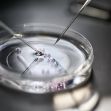A mechanical failure at a San Francisco fertility clinic caused plaintiffs to lose three embryos that they planned to use for in vitro fertilization. The couple, who hoped for a child, had purchased a homeowner’s insurance policy for the embryos. Their policy, however, would only reimburse them for “direct physical losses” from one of 16 “specifically enumerated peril(s).” When plaintiffs filed a claim, the insurance company investigated and concluded that the defective, thawed embryos were not caused by “one of the named perils.” Their file was closed and a lawsuit followed.
Sherlene and Lawrence Wong sued the Stillwater Insurance Company for breach of contract, negligence, and unjust enrichment in 2018. Three of their zygotes had been stored in cryogenic storage tanks at the Pacific Fertility Center (PFC) since 2015. The tanks used liquid nitrogen to assure that embryos were stored at the very low temperature they needed to remain viable. Three years later, the vacuum seal on the storage tank malfunctioned and the Wong’s embryos thawed. Their fertility doctor told the couple they “should consider the embryos compromised, no longer viable, and lost.”
Stillwater’s policy was reviewed by the trial court, which found that the Wongs’ claim did not include any of the specific perils covered by their policy. The Wongs were not able to provide evidence of the “direct physical loss” their policy required. San Mateo Superior Court Judge Nancy Fineman granted Stiilwater’s summary judgment motion, and a unanimous decision by Division Two of the First District of California Court of Appeal affirmed it on June 30. The decision was authored by Justice James Richman, who noted that physical loss was distinguishable from property damage.
Richman’s ruling began with a detailed account of the Wongs’ insurance policy, which covered personal property loss up to $502,720. However, their policy covered only a list of “specific perils.” When the loss occurred, the Wongs’ attorney filed a claim for a total of $1,550,370, because three embryos were compromised and had “financial value well in excess of the personal property limits” of the Wong’s policy.
Stillwater’s attorney and claims investigator determined she could not “ascertain” whether the insured zygotes were compromised or still viable. More importantly, she said there “was no evidence that the claimed damage resulted from any of the 16 perils” listed in the policy. These perils included such events as fire, lightning, windstorms, explosions, riots, aircraft, smoke, vandalism, theft, volcanoes and water damage. Mechanical failure of a storage tank was not a listed peril, and the Wongs failed to “provide actual evidence” of the reason why the tank failed to maintain the proper temperature. This reason had to match one of the 16 listed perils.
Stillwater’s motion for summary judgment noted that even if plaintiffs could provide evidence that the loss was caused by the faulty vacuum seal, it would still fail to match one of the 16 listed perils, not even the one for water damage, because “liquid nitrogen is not steam.” Nor was the failure due to the peril described as an explosion. Rather, at one point during his deposition, a doctor retained by the plaintiffs, called it more of an “implosion.” The doctor was also not designated as an expert witness and the court found that his 156-page deposition was inadmissible because it was only “hearsay and lacking foundation.”
Richman wrote, “Indeed, we note that if we understand the Wongs’s argument, it would mean that regardless of the hearsay, regardless of its source, a person opposing summary judgment could “testify” as to some hearsay and then search for something admissible to support it at trial. This cannot be the law.”
The opinion then turned to the propriety of a grant of summary judgment, which the court had to decide “independently whether the facts warrant… judgment for the moving party as a matter of law.” Richman concluded that summary judgment was correctly granted, primarily because the Wongs could not demonstrate a “direct physical loss.”
This ruling was supported by the Wongs' inability to prove that the embryos had actual physical damage because PFC refused to test them. Their doctor’s conclusion that the embryos were no longer viable, and her statement that without a test, there was “no way to know whether the Wong’s embryos had actual physical damage was devastating to the Wong’s claim.” Thus, the mere possibility did not create a “triable issue of fact as to physical loss.”
The Wongs also have claims pending against Pacific Fertility Center and Prelude Fertility, Inc., PFC’s parent company, as well as the manufacturer of the nitrogen tank and “any others who share responsibility.” No amount of damages can ever compensate for the loss of a child. But future litigation, against the other defendants whose liability is not linked to just 16 specific perils, could bring the Wongs some closure.






